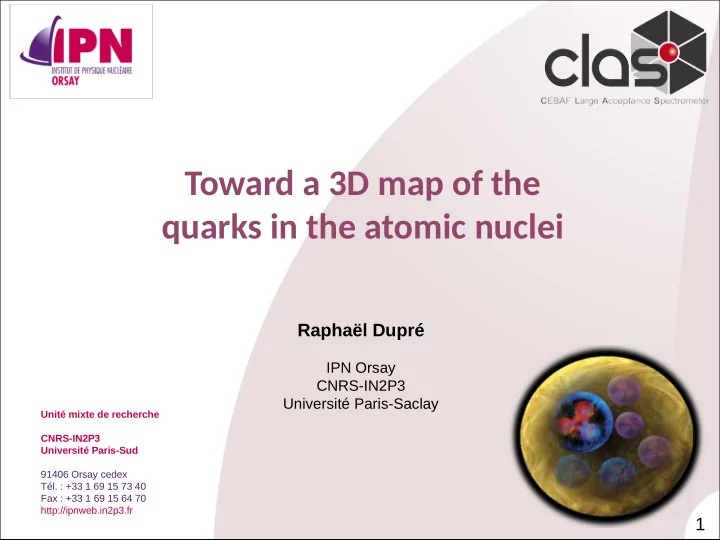

Toward a 3D map of the quarks in the atomic nuclei Raphaël Dupré IPN Orsay CNRS-IN2P3 Université Paris-Saclay Unité mixte de recherche CNRS-IN2P3 Université Paris-Sud 91406 Orsay cedex Tél. : +33 1 69 15 73 40 Fax : +33 1 69 15 64 70 http://ipnweb.in2p3.fr 1
DVCS on Nuclei • Coherent and incoherent – Nuclei vs bound nucleon • The spin-0 simplifjcatjon – Only one GPD for Helium-4 → 2 CFFs – Allows model independent extractjon of the GPD • Impulse plane wave approximatjon – Convolutjon of nucleons in nuclei and partons in nucleons distributjons – Only nucleons are considered → Allows to probe non-nucleonic degrees of freedom – No interactjon with A-1 – Fermi motjon (including some ofg-shellness) • Perfect probe into the EMC efgect – Ofger localizatjon with the t dependence – Gives access to non-nucleonic degrees of freedom 2
Measuring DVCS on Helium • Jefgerson Laboratory – Provides a 6 GeV electron beam (now up to 12 GeV) – High quality beam • 100% duty factor • Around 150 µm wide • Intensity up to 100 µA • CEBAF Large Acceptance Spectrometer – Nearly 4π – Ofgers electron and proton identjfjcatjon for our experiment – Recording rates up to 8 kHz 3
Experimental Apparatus • Experimental challenges – Detectjng very forward photons – Detectjng very low energy alphas (~7 MeV) • Radial Time Projectjon Chamber – Small TPC placed around the target • Inner Calorimeter – Very forward electromagnetjc calorimeter 4
The RTPC detector • The RTPC in details – 250mm long / 150mm diameter – Drifu region of 30mm (1500V) – Amplifjcatjon is obtained with 3 layers of GEM – Signal is collected on 3200 pads in 100 ns tjme bins • Solenoid – 4.5 T to shield from Moller electrons and curve partjcles in the RTPC • Calibratjon – Use of Helium elastjc scatering obtained with 1.2 GeV electron beam 5
Selectjng DVCS • Partjcle Identjfjcatjon – Identjfjcatjon of electron, protons, photons and helium nuclei • Exclusivity cuts – Perform missing energy and momentum cuts to insure that we have all the products • Correctjons – Subtract the irreducible π 0 background – Associated systematjc errors appear much smaller than the statjstjcal errors • Identjcal for both coherent and incoherent channels 6
The Coherent DVCS • Coherent DVCS on helium – Shows very strong beam spin asymmetry – Expected factor ~2 increase from PWIA predictjon • Interpretatjon – The very strong signal proves that we are indeed probing the nuclei as a whole – Predictjons based on binding are signifjcantly below our measurement 7
Extractjon of the CFF • Simple extractjon – Spin-0 → 1 GPD → 2 CFF – Their difgerent contributjons in phi allows to separate their contributjons – The difgerent contributjons are exactly calculable within perturbatjve QCD – We are mostly sensitjve at the imaginary part – More precise measurement will be needed to extract the real part 8
The Generalized EMC Ratjo Generalized EMC ratjo – Coherent/proton • The expected form factor slope is present V. Guzey and M. Strikman Phys. Rev. C 68, 015204 – Incoherent/proton • Suppressed compared to the binding model from S. Liut and S.K. Taneja Phys.Rev. C72 (2005) 032201 9
Going to CLAS12 • An extension at CLAS12 – For more statjstjcs – And more kinematjc coverage • Possibility to look at other nuclei and processes – DVCS on deuterium – Tagged EMC • The ALERT detector – Difgerent technologies: • Drifu Chamber & Scintjllators • On going R&D – Faster detector • Allow integratjon in the trigger • Necessary to get maximum luminosity 10
Summary • We now explore nuclei in 3D with DVCS – The theory is solid and actually simpler than for nucleons – Data has confjrmed our expectatjons • It is important to expend measurements to nuclei – It is what we need to explain the EMC efgect – It is a whole new view into the nuclei beyond nucleons • The fjrst exclusive measurement of nuclear DVCS has been performed in JLab – Using a low energy RTPC for helium recoils – First results show basic trends: • Large asymmetry signal for coherent DVCS • Suppression on the incoherent channel • Perspectjves – More theoretjcal work will come with these new results – We will extend our measurement with JLab 12 GeV 11
Recommend
More recommend